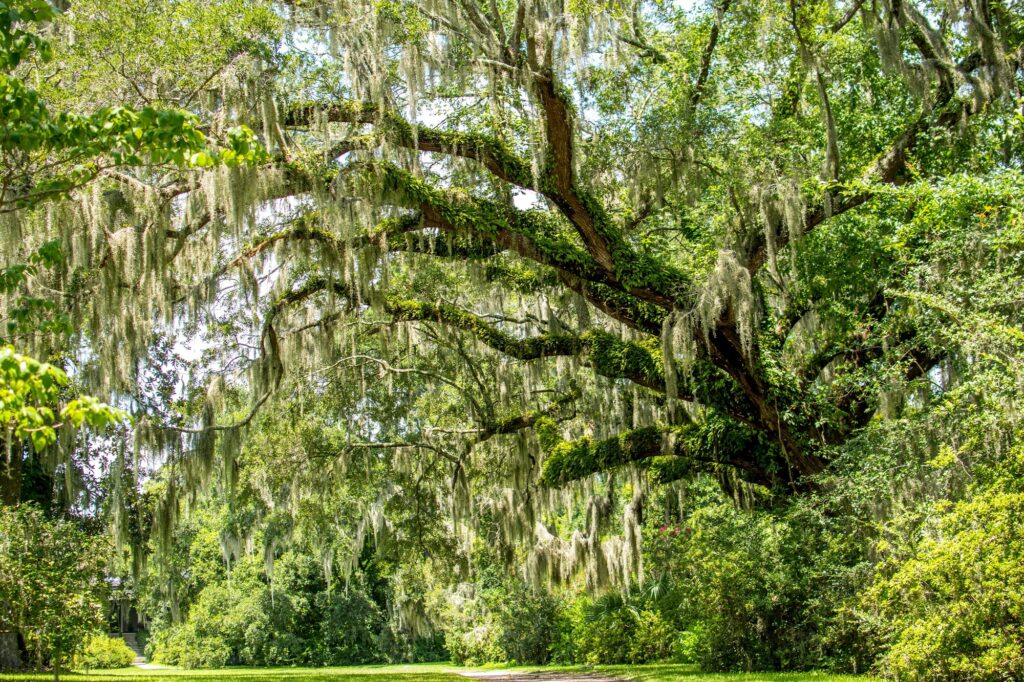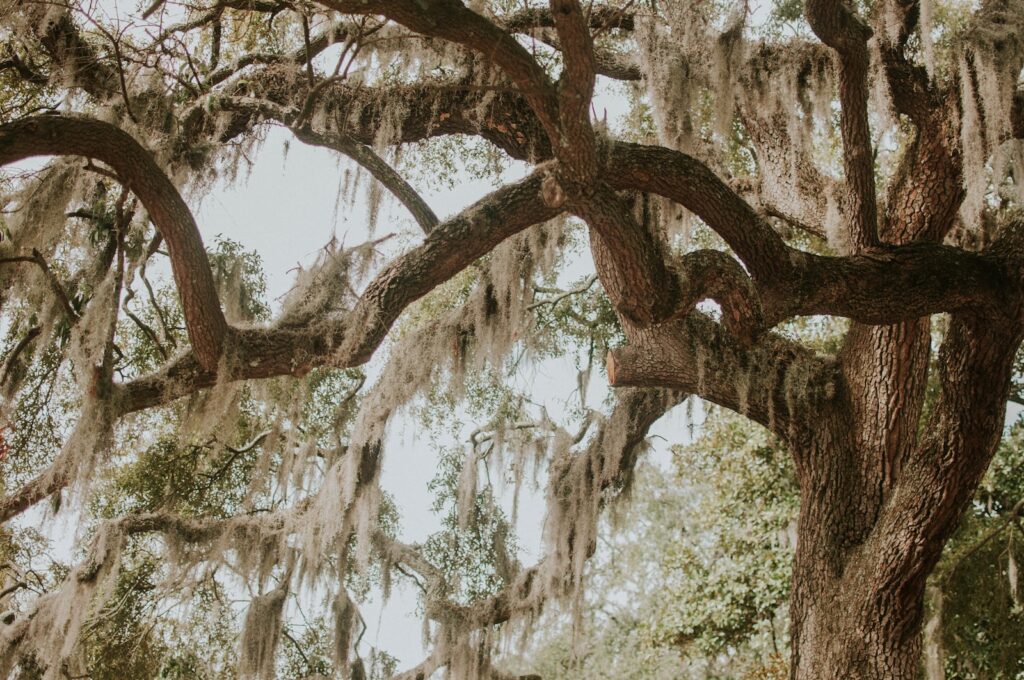12 Interesting Facts About Spanish Moss

Introduction
Spanish moss is an iconic plant of the American South. This ethereal plant cloaks oak trees and palms throughout the humid coastal regions of the southeastern U.S.
With its wispy tendrils and grayish-green hue, Spanish moss adds texture and mystery to southern landscapes. But there’s much more to this plant than meets the eye.
Spanish moss has a long history intertwined with southern culture. From its varied uses to its horticultural heritage, this plant tells a fascinating story.
Here are 12 intriguing facts about the beloved and beguiling Spanish moss:

1. It’s Not a Moss
Despite its name, Spanish moss is not a true moss. It is a flowering plant in the bromeliad family, making it a relative of the pineapple. Its technical name is Tillandsia usneoides1.
2. Spanish Moss is an Epiphyte
Spanish moss is an epiphyte, meaning it grows on other plants but does not parasitize them or take nutrients from them. It anchors to trees with tiny scales along its stems and leaves, absorbing water and minerals from the air and rainfall2.
3. It Grows Very Slowly

This air plant is exceptionally slow-growing, adding just a few centimeters in length each year. Thus, the long beards of moss seen hanging from tree limbs are often decades old. Their slow growth allows them to thrive even through storms and drought.
4. Spanish Moss Helps Its Ecosystem
This plant creates microhabitats for wildlife. Birds use it to build nests while three species of bats, including the endangered Seminole bat, roost in its tangles. It also shelters insects, spiders, tree frogs, lizards, and snakes.
5. It Has Air-Purifying Qualities
Spanish moss absorbs airborne particles along with moisture and nutrients. This makes it an excellent natural air filter. But pollution causes it to recede, so it can indicate environmental quality.
6. The Plant Has Medicinal Uses
Native Americans traditionally used Spanish moss to treat fever, chills, and rheumatism. Today, research shows extracts from the plant have antibacterial properties that help heal wounds and may also reduce blood sugar levels.
7. It Has Strong Cultural Ties

This plant is woven into southern heritage and lore. Its romantic, unkempt appearance has made it an icon of Southern Gothic literature and art. Spanish moss also holds spiritual meaning for groups like Louisiana’s Houma tribe.
8. People Once Used It Commercially
Early settlers and Native Americans wove the plant’s strong inner fibers into fabric. Later, it was harvested commercially for mattress and upholstery stuffing, shipped by the boxcar-full to factories. Though no longer used this way, Spanish moss still has many applications.
9. The Plant Has Versatile Uses
In addition to decor and crafts, Spanish moss has served as insulation, a tinder for fires, a pottery ingredient, and a thickener for plaster. Gardeners use it as mulch and its boiled “tea” makes an excellent natural fertilizer. It even helped make concrete-like tabby mortar used in Southern architecture.
10. There are Many Myths About It
Folklore often paints Spanish moss as a threat, but it’s mainly benign. Contrary to popular belief, it generally doesn’t host chiggers or harm trees. It likely doesn’t weigh down healthy branches, though it may indicate existing weakness by thriving on struggling trees.
11. Its Origins Are Mysterious
There are many tales about how Spanish moss got its name, but its origins remain uncertain. One story claims it resembled the long beards of Spanish conquistadors. Another legend says it was named by an American Indian who found the hairy clumps reminiscent of the Spaniard, Gorez Goz.
12. It’s Making a Comeback
Though Spanish moss declined in past decades due to pollution and overharvesting, conservation efforts seem to be reversing the trend and restoring this elegant plant to southern trees. Its re-emergence is helping revive both natural beauty and cultural heritage.

Frequently Asked Questions
Is Spanish moss a moss?
No, despite its name, Spanish moss is not a moss. It is a flowering plant in the bromeliad family, making it a relative of the pineapple. Its technical name is Tillandsia usneoides .
How does Spanish moss grow?
Spanish moss grows very slowly, adding just a few centimeters in length each year. The long beards seen hanging from trees are often decades old. It propagates most often by pieces breaking off and rooting, rather than by seeds.
Is Spanish moss harmful to trees?
No, Spanish moss is not a parasite and does not take nutrients from the trees it grows on. It anchors using tiny scales and absorbs water and minerals from the air and rain. However, very thick growth can block light or weigh down weaker branches.
How often should you water Spanish moss?
Spanish moss should be watered whenever it starts to appear dry and gray, about once a week in warm weather or every few weeks in winter. It can withstand short periods of drought but prefers high humidity. Water by misting, dunking, or soaking the entire plant.
What’s the best way to grow Spanish moss indoors?
Spanish moss thrives best with bright, indirect light and high humidity, around 50% or higher. Let it hang freely rather than bundling up. Place near other plants or humidifiers to help increase moisture. Keep away from direct hot sunlight.
What are some uses for Spanish moss?
Spanish moss has many traditional uses, from clothing material to packing material to mulch. It has also been used medicinally and commercially for upholstery stuffing, though no longer. Extracts may have antibacterial properties. But it has no nutritional value as livestock feed.
Is Spanish moss making a comeback?
Yes, after declining due to overharvesting and pollution, conservation efforts seem to be reviving Spanish moss. Its re-emergence is restoring the plant’s beauty and cultural heritage across the southeastern US.
Conclusion
Spanish moss has played a leading role in the scenery, ecology, and livelihood of the southeastern United States for hundreds of years. This resilient bromeliad has supported ecosystems, economies, architecture, and art through the ages.
With its rebounding resilience allowing it to once again drape gracefully from southern trees, the future looks bright for Spanish moss. No longer taken for granted, this beautiful botanical and cultural icon continues working its magic, cloaking the South in mystery and charm.
- https://sfyl.ifas.ufl.edu/natural-resources/sustainability-spanish-moss/ [↩]
- Spanish Moss, Samuel E. Hand, Jr., and Edwin R. Duke, cafs.famu.edu/ pdf [↩]





